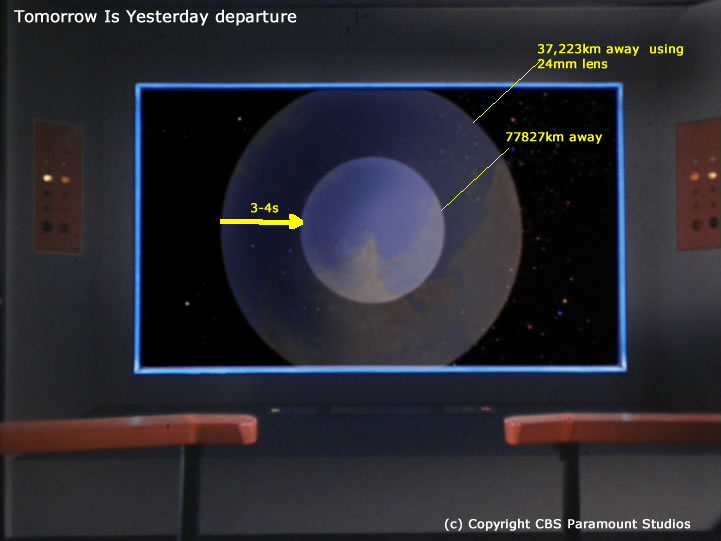But 1.8 hours to Jupiter is a VELOCITY of between .25 and .5C. ANY level of acceleration would have to produce high relativistic velocities relatively quickly in order to cover that kind of distance. It couldn't be traditional acceleration as we understand it; even at a thousand Gs it would take the better part of a week to reach those velocities. Futuristic material or not, NOTHING is going to withstand those kinds of G-forces; your impulse engine will probably tear off its mount the instant you fire it up.
For the TMP instance (and it is fairly unique) you could say they were channeling impulse power into the warp drives to achieve "sub-warp" speed, hence the reason Kirk ordered a fractional warp factor instead of "full impulse power" or something like that as in other references. Beyond which, outside of TMP accelerations visibly accounted are closer to 10 to 15Gs maximum, usually much lower.
- Greater than 1 atmosphere external hull pressure (no top number given) - "Who Mourns for Adonais?"
- Unshielded atmospheric flight - "Tomorrow is Yesterday"
- Unshielded immersion in space protoplasm and withstanding shockwave/explosion - "The Immunity Syndrome"
- Magnetic/ion storms producing pressure, vibrations and capable of pulling starships great distances - "Where No Man Has Gone Before", "Court Martial", etc
- "Turbulent waves of space displacement" - "City on the Edge of Forever"
- Tractor beams capable of stopping the Enterprise while even at warp - "Corbomite Maneuver", "Doomsday Machine", etc
- Warp power (as in too much) - "The Changeling"
- >10 G Impulse acceleration - "Squire of Gothos"
- Flying right up to a star - "Tomorrow is Yesterday", "Operation: Annihilate"
Apart from unshielded atmospheric flight, it strikes me that the best points of comparisons will all come from interplanetary space craft. The problem is that most of these are unmanned probes so the introduction of crew spaces will screw things up, so in this case I think the best candidate for comparison would be the Soviet TKS module they used on Mir and Salyut. It wasn't designed for interplanetary flight, of course, but given the shit that happened to the Mir over the years (all the while remaining intact) it seems to me a pretty fitting analog.
TKS has a
habitable volume of about 45 cubic meters. It IS roughly cylindrical, with a length of 13.2 meters and a diameter of 4.15 meters for a TOTAL volume of (approximately) 320 cubic meters. I'll get back to habitable volume in a minute.
From the volumetrics page, we know Enterprise has a volume of about 216,000 cubic meters. TKS at 320 cubic meters weighed 17 tons; it included 12 tons of payload and 4 tons of fuel for a total loaded weight of about 33 tons. That's a density--FULLY LOADED--of about 103 kilograms per cubic meter.
Those densities, of course, reflect modern construction materials and design principles for space craft, but in my mind it's unlikely the
principles are going to change dramatically in the next few centuries, only the
materials. So using TKS' vessel density as a baseline, a starship at 216,000 cubic meters would have a loaded mass of 22,248 tons. Mind you, this is the mass of the Enterprise IF it was made entirely out of TKS modules. TKS is a sturdy craft, but it might not be sturdy enough to stand up to alot of these pressures. So add a reinforced load-bearing "outer hull" in the exact shape of the Enterprise to encapsulate those modules. The outer hull is shiny and important, but its disposable; all it has to do is hold its shape under stress, it doesn't have to retain atmospheric pressure or support the weight of the ship's internal components. The same site tells us Enterprise has a SURFACE AREA of 60,700 square meters; if you assume the outer hull is about a ten centimeters thick, AND if you assume that it's made out of depleted uranium (d.uranium anyone?) then your ship is encased in 6,070 cubic meters of uranium with a total mass of 115,330kg.
I think this gives us a good upper and lower limit to play with: the extreme lower limit of about 23,000 tons (using modern-day design principles) and the extreme upper limit of 138,400 tons (modern day design principles combined with an heavy armored shell). Now, the other thing to remember is that for the TKS spacecraft only 15% of its internal volume is actually habitable (20% for space station modules). Enterprise is probably more like 60% habitable volume, so that'll screw around with the density figure about; the presence of strong but lightweight materials will ALSO screw around with the density figures, especially if the outer hull is made of something considerably less dense than depleted uranium (the ship would only weigh about 80,000 tons if the outer hull were made of lead).










 ) there are probably more examples though
) there are probably more examples though 
